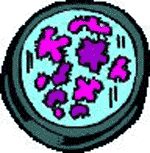|
|
 |
REMINERALISATION
Have a look at the process of remineralisation and try to describe in your own words what you can see! Afterwards you should be able to fill in the missing words in the following worksheet.
|
|
process of remineralisation, image by Lucinda Spokes, animated by Julia Heres
Here are the missing words:
- 1000 years
- a day
- bacteria
- can't
- climate
- deep
- nitrogen
- no
- oxygen
- phosphorous
- photosynthesis
- phytoplankton
- remineralisation
- sunlight
- surface
- carbon dioxide (CO2) and water
- zooplankton
|
|
………………………… (phyto = plant, planktos = to wander) are single celled plants which live in the surface waters of the oceans. They use ……………., ……………………………… , in a process called ………..……………, to produce organic compounds which they use for food and to make their cells.
The waste product is …………………. and this makes it possible for animals to live on Earth. Phytoplankton remove almost as much carbon dioxide from the air as land plants and, therefore, help regulate our ……….………
Phytoplankton also need nutrients to grow. They need a wide variety of chemical elements but the two critical ones are ………………. and ……………………. since they are needed in quite large amounts but are present in low concentrations in seawater.
|
 |
 |
|
Clipart 1, Hemera, Big Box of Art
|
|
 |
Phytoplankton grow very quickly, only living for …………. or so. When they die, they are eaten by …………………… or ……………………….(tiny animals) which convert their organic matter back into carbon dioxide, release the nutrients they have used back into the water and use up oxygen. This process is known as …………………………. and it takes place mainly in …………………… waters.
The carbon dioxide escapes back to the air or is reused, along with the re-released nutrients, in photosynthesis. If this happens, there is …………….. change in atmospheric carbon dioxide levels. |
However, if the phytoplankton sink out of the surface and are remineralised in the …………….. ocean, the nutrients and carbon dioxide are stored in the deep ocean and the carbon dioxide ………….. return to the atmosphere. This lowers carbon dioxide levels in surface waters, allows more carbon dioxide to enter from the air and helps reduce atmospheric carbon dioxide concentrations.
The carbon dioxide only returns to the air when ocean circulation brings the deep water back to the surface, a process which takes around …………….. This is the biological pump.
|
 |
 |
 |
|
Ocean, courtesy: Hemera - Big box of art
|
|
About this page:
- Author: - Dr. Y. Schleicher- University of Nürnberg - Germany
- scientific reviewing: Lucinda Spokes
- educational reviewing: Dr. Schrettenbrunner / J. Heres
- last update: 07.11.03
|
|
 |
|









